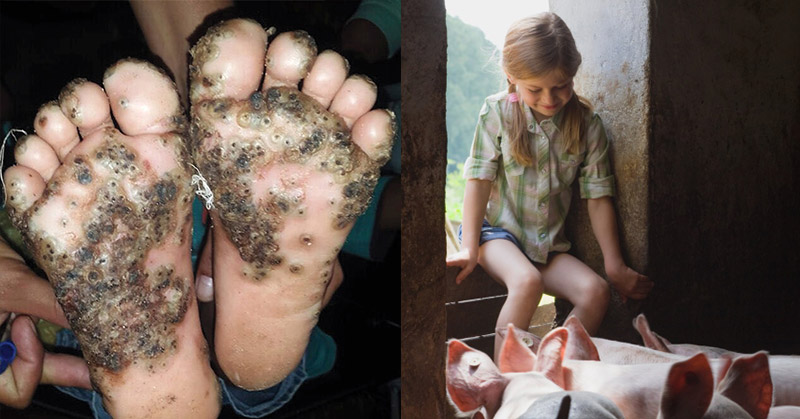A ten-year-old running barefoot through a pigpen might sound innocent and cute to those who are unaware of the potential consequences. Unfortunately, this wasn’t the case for a young girl who developed multiple itchy patches as a result of the innocent act. The lesions on her feet were brown in color and had black dots in the center – and this was caused by a parasitic sand flea infestation. [1]
It was in the New England Journal of Medicine [2] that her case was first published, which included the horrible pictures of the papules on her feet. According to reports, the girl went to Brazil on vacation with her family – where she got the infection. This was two weeks before she was taken to the clinic.
Fortunately, at this point, she is well and healthy – and has received the recommended treatment.
The diagnosis by doctors working at the clinic was tungiasis – which is a cutaneous parasitosis caused by female sand flea Tunga penetrans. The causal organisms usually burrow its way into the toes, sole, heels or sometimes entire feet of the host. It then feeds on the blood of the host which then leads to an increase in body volume of the parasite and itching for the host.
In the case of the ten-year-old girl, her doctors removed the fleas completely and treated the wounds caused by the infestation. There were no further complications in her feet [3] as they healed completely. There was also a total remission of the lesions.
According to the World Health Organization [4], Tunga penetrans is native to the tropical and subtropical regions of South America, Central America and the Caribbean [5] (Brazil is in South America). The parasite tends to thrive more in places with poor living conditions such as remote villages of third world countries and shanty towns.
Prevention
Whether you live in an area or travel to one where there is a known tungiasis risk, prevention is key. To help prevent infection from Tunga penetrans, it’s best to wear close-toed shoes to act as a barrier [6]. The addition of a plant-based repellent known as Zanzarin has been shown to have even greater benefit[6][7].
The Bottom Line
You shouldn’t go into panic mode if you already have a trip planned to Brazil – you and your family just have to exercise more caution. Either avoid areas that have a higher risk or make sure to adopt proper preventative measures. In the end, everyone is happy, the girl is feeling much better, and there was no permanent harm to her feet.
Sources
- https://vt.co/animals/stories/this-is-the-snake-infested-island-thats-so-dangerous-it-is-forbidden-for-people-to-visit/
- https://www.nejm.org/doi/full/10.1056/NEJMicm1810588
- https://vt.co/lifestyle/man-cruelly-nicknamed-sideshow-bob-reveals-he-cant-get-married-due-to-his-size-19-feet/
- https://www.who.int/lymphatic_filariasis/epidemiology/tungiasis/en/
- https://vt.co/lifestyle/travel/stunning/caribbean-island-lets-play-rescue-dogs-day/
- https://emedicine.medscape.com/article/231037-treatment#d11
- https://www.ncbi.nlm.nih.gov/pubmed/24069481

